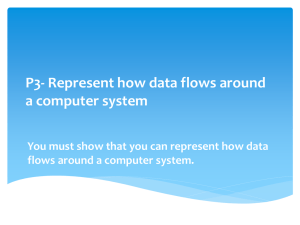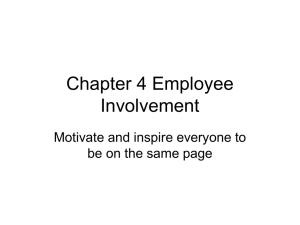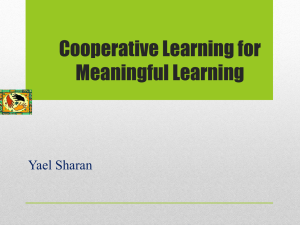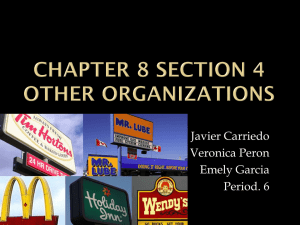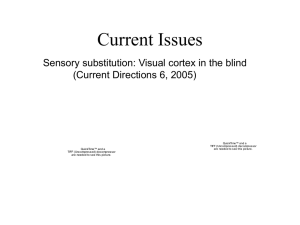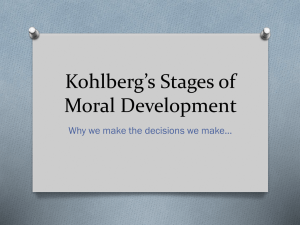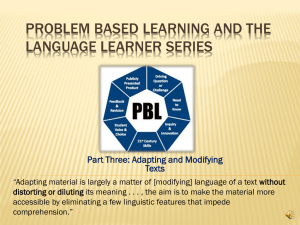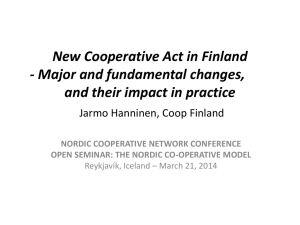p - Department of Management
advertisement
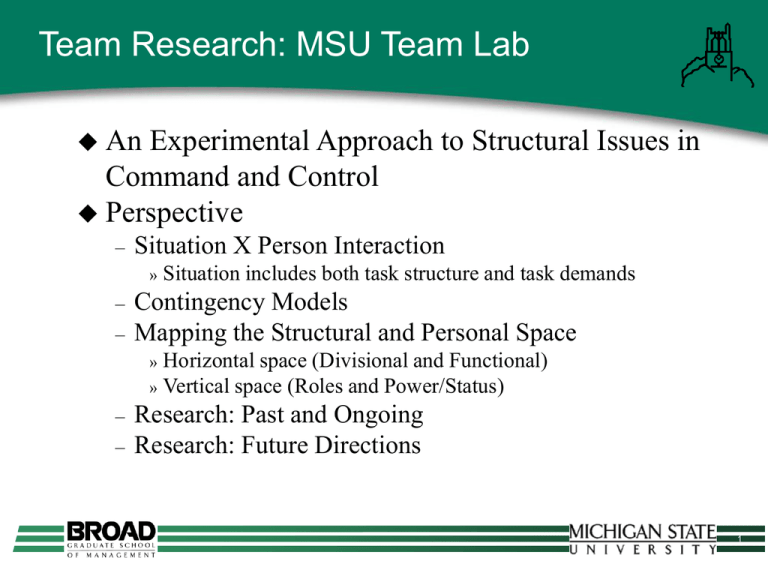
Team Research: MSU Team Lab An Experimental Approach to Structural Issues in Command and Control Perspective – Situation X Person Interaction » – – Situation includes both task structure and task demands Contingency Models Mapping the Structural and Personal Space Horizontal space (Divisional and Functional) » Vertical space (Roles and Power/Status) » – – Research: Past and Ongoing Research: Future Directions 1 Research on Adaptation Review and discuss 4 studies focused on adaptation in teambased work environments Study Form of Adaptation structure adaptation as a means of adapting to communication losses during the course of performing a task Publication Status Team Adaptation & Postchange Performance: Effects of Team Composition in Terms of Members’ Cognitive Ability and Personality Role Published in Journal of Applied Psychology, 2003, 88, 1, 27-39 Backing Up Behaviors in Teams: The Role of Personality and Legitimacy of Need Backing Published in Journal of Applied Psychology, 2003, 88, 3, 391-403 Team Learning: Collectively Connecting the Dots Team Published Adapting to Unexpected Changes in Team Size: The Role of Individual Differences & Team Processes Adapting up behaviors as a form of adapting to new adversary tactics learning as a means of adapting to new adversary technology team size to unexpected reductions in in Journal of Applied Psychology, 2003, 88, 5, 821-835 Data collected in Spring 2004; manuscript to be completed Fall 2004 2 Adapting to Communication Losses (Lepine, 2003) Purpose: Examine the factors that allow teams to effectively adapt their routines in response to unforeseen changes in the work environment Primary contribution: – Extension of individual-level, cognition-focused adaptation research to consider team-level behavior 3 Adapting to Communication Losses Theory & Conceptual Model Teams must be able to deal with unanticipated change and modify their routines (Argote & McGrath, 1993) Key questions: – – What variables predict the extent to which teams adjust their routines in response to unforeseen change? Do the same factors predict team performance prior to and after unforeseen change? Member Cognitive Ability Member Achievement Role Structure Adaptation Member Dependability Post Change Decision-Making Performance Member Openness to Exp. 4 Adapting to Communication Losses Hypotheses Member Cognitive Ability Member Achievement Hypothesis 2a, 3a, 4a, & 5a + + Hypothesis 1 Role Structure Adaptation Member Dependability Member Openness to Exp. − – Post Change Decision-Making Performance + Hypotheses 2b, 3b, 4b, & 5b: – + Member cognitive ability, achievement, and openness to experience positively related to team decision-making performance after change Member dependability negatively related to team decision-making performance after change Hypotheses 2c, 3c, 4c, & 5c: – Role structure adaptation mediates relationship between member cognitive ability, achievement, dependability and openness to experience and team decisionmaking performance after change 5 Adapting to Communication Losses Research Design & Methods TIDE2 decision-making simulation 73 three-person teams (college juniors and seniors) Random assignment to teams and roles Training and practice designed to facilitate development of team routines Role structure adaptation measured using (a) count method and (b) rated measure 6 Adapting to Communication Losses Findings & Implications All hypotheses received empirical support Suggests that the set of individual differences that predict team performance in a changing situation may be quite distinct from those that predict performance in more routine situations Implication: Effective team staffing should consider the degree to which the team is likely to experience unexpected change 7 Adapting to New Adversary Tactics (Porter et al., 2003) Purpose: Examine the effects of team member personality and legitimacy of need on backing up behaviors in teams Primary contribution: – – – Differentiates help in terms of its legitimacy of need Examines backing up behavior at the team-level Provides an objective measure of whether help actually ensued 8 Adapting to New Adversary Tactics Conceptual Model & Hypotheses Input Personality of back up recipient Personality of back up provider Legitimacy of need (direct & moderator effect) Legitimacy of need positively relates to backing up (H1) Recipient conscientiousness and legitimacy of need interact to predict backing up (H2) Recipient emotional stability and legitimacy of need interact to predict backing up (H3) Recipient extraversion and legitimacy of need interact to predict backing up (H4) Provider conscientiousness and legitimacy of need interact to predict backing up (H5) Provider emotional stability and legitimacy of need interact to predict backing up (H6) Provider agreeableness and legitimacy of need interact to predict backing up (H7) Team Process Backing up behavior (# of help attacks) Backing Up Behavior: Discretionary provision of resources and task-related effort to another member of one’s team that is intended to help that team member obtain the goals defined by his or her role when it is apparent that the team member is failing to reach those goals 9 Adapting to New Adversary Tactics Research Design & Methods DDD decision-making simulation 71 four-person teams (college juniors and seniors) Individuals randomly assigned to teams / roles Teams randomly assigned to high or low-legitimacy condition (based on resource allocation and workload distribution) Hierarchical regression used to test moderation effects 10 Adapting to New Adversary Tactics Findings & Implications Hypotheses 1, 2, 4, and 6 (no support for H3, H5 or H7) – Legitimacy of need predicts backing up behavior – Legitimacy of need interacts with back up provider and recipient personality to predict backing up behavior Implication: – Personality of the back up provider and recipient can differentially affect the effectiveness of backing up behavior in teams » – E.g., showing good discrimination on when to provide back up Effective team staffing should consider the degree to which team members will experience workload distribution imbalance – and compose the team accordingly » E.g., conscientious and extraverted recipients » E.g., emotionally stable providers 11 Adapting to New Adversary Technology (Ellis et al., 2003) Purpose: Examine how project teams learn and how the speed of the learning process can be improved within teams of individuals with no prior history or knowledge of each other’s strengths and weaknesses Primary contribution: – Expands traditional conceptualization of learning process at the individual level to the team level » Recognizes that team members learn from their own direct experience AND the experience of other team members 12 Adapting to New Adversary Technology Theory & Conceptual Model Input Member cognitive ability Workload distribution (even/uneven) Team Process – Team learning Member agreeableness and openness to experience Team structure – – – Pair-based Functional Divisional Team Learning Relatively permanent change in the team’s collective level of knowledge and skill produced by the shared experience of the team members Accounts for multiple sources of learning in teams – Individual team member’s ability to individually acquire knowledge and skill – Team members’ ability to collectively share information 13 Adapting to New Adversary Technology Hypotheses Input Member cognitive ability Workload distribution (even/uneven) Member agreeableness and openness to experience Team structure – – – Pair-based Functional Divisional Higher levels of general cognitive ability generates higher levels of team learning (H1) Evenly distributed workloads will engender greater team learning than unevenly distributed workload (H2) Higher levels of agreeableness will generate lower levels of team learning (H3) Higher levels of openness to experience will generate higher levels of team learning (H4) Project teams using pair-based structures will learn more than those structured functionally or divisionally (H5) Team Process Team learning 14 Adapting to New Adversary Technology Research Design & Methods DDD decision-making simulation 109 four-person teams (college juniors and seniors) Individuals randomly assigned to teams / roles Teams randomly assigned to paired, functional and divisional structures Workload distribution manipulated within teams across 2 different 30-minute simulations Team learning based on the nature of engagement toward a series of Unknown targets – Effective engagement / efficient engagement Repeated measures regression used to analyze data 15 Adapting to New Adversary Technology Findings & Implications Findings support H1, H2, H3, and H5 Cognitive ability, agreeableness, workload distribution and team structure impact project team learning Implication: – For project teams operating in contexts that demand learning, effective team staffing should select individuals with high cognitive ability – and not all members should be high in agreeableness – Ensuring even workload distribution and employing team structures where two members have access to the same information helps to eliminate learning barriers 16 Adapting to Reductions in Size (DeRue et al., 2005) Purpose: Examine the factors that allow teams to effectively adapt in response to unforeseen reductions in team size Primary contribution: – – Examines the compositional factors and processes that enable teams to effectively adapt to reductions in team size Explores multiple forms of reductions in team size 17 Adapting to Reductions in Size Theory & Conceptual Model Input Team structure Task environment Individual differences Form of reduction in team size Examined Mediators Post-Change Team Performance Trusting Structuring Bonding Adapting Learning 3 forms of reducing team size: – Eliminate hierarchy (eliminate the team leader role) – Integrate hierarchy (leader replaces displaced team member in action role) – Maintain hierarchy (leader position remains; displaced team member not replaced) 18 Adapting to Reductions in Size Research Design & Methods DDD decision-making simulation ~75 five-person teams (college juniors and seniors) Individuals randomly assigned to teams / roles Teams randomly assigned to conditions Data analysis in process 19 Adapting to Reductions in Size Preliminary Findings Offense Scores (Game 2 Mean) Defense Scores (Game 2 Mean) 1250 40500 1240 40000 1230 39500 1220 39000 1210 38500 1200 38000 1190 37500 1180 37000 1170 36500 Control Eliminate Leader Integrate Leader Maintain Hierarchy Control Eliminate Leader Integrate Leader Maintain Hierarchy Form of reduction significantly affects team performance – – E.g., Leader may not be an adequate substitute for task performing roles E.g., Losing the team leader has little impact on offensive performance but significantly detracts from team’s ability to monitor the team environment 20 Adapting to Reductions in Size Preliminary Findings (cont.) Structuring (Game 2 Mean) Bonding (Game 2 Mean) 4 4 3.9 3.9 3.8 3.8 3.7 3.7 3.6 3.6 3.5 3.5 3.4 3.4 Control Eliminate Leader Integrate Leader Maintain Hierarchy Control Eliminate Leader Integrate Leader Maintain Hierarchy Losing a task performing team member engenders more structuring of roles and responsibilities in the team Loss of team leader significantly hinders team bonding (potentially more taskfocused) 21 Adapting to Reductions in Size Emerging Implications Shifting traditional, hierarchical teams to self-managing teams with no formal leader does not always result in superior team performance – Potential short-term bonding loss – Loss of external monitoring function If forced to downsize, which team members should stay / go? – Key considerations: Task environment? Short-term or long-term perspective? 22 Structural Asymmetry Research Review and discuss 4 studies focused on structure in team-based work environments Study Form of Structure resource allocation structures interact with the type of environment to determine team performance Publication Status Structural Contingency Theory and Individual Differences: Examination of External and Internal Person-Team Fit Horizontal Published in Journal of Applied Psychology, 2002, 87, 3, 599-606 Asymmetric Adaptability: Dynamic Team Structures as One-Way Streets Horizontal In press at the Academy of Management Journal The Asymmetric Nature of Structural Adaptation: The Impact of Centralizing and Decentralizing on Group Outcomes Vertical Manuscript The Impact of Hybrid Team Structures on Performance and Adaptation: Beyond Mechanistic and Organic Prototypes Hybrid Data resource allocation structural changes may not be as easy to make in one direction as they are in the other decision-making authority structural changes may not be as easy to make in one direction as they are in the other horizontal and vertical structures outperform redundant ones under revision, to be submitted to the Journal of Applied Psychology collected in Spring 2003; manuscript to be completed Fall 2004 23 Purpose Examine the impact of team structure on team performance and effectiveness by addressing: – – – the fit of structural conditions to task demands structural adaptability to changes in task demands the internal fit of team members to team structures 24 Dimensions of Structure 25 Fixed Structures (Hollenbeck et al., 2002) Structural Contingency Theory – Fit of Team Structure to Environment (External Fit) – No one best way to structure teams in organizations Team performance will be an interactive effect of the team structure and its task/problem environment Types of structure – Divisional: People are grouped based on geographic region » » – Broad Roles Highly independent Functional: People are grouped on the basis of the type of the work they perform » » Narrow/specialized roles High levels of interdependence 26 Fixed Structures (Hollenbeck et al., 2002) Fit of individuals’ characteristics to the demands placed on team members by different structures – In divisional structures, jobs are complex and have fairly high levels of autonomy » – In functional structures, roles are fragmented and there are high levels of interdependence, making coordination very important » – High cognitive ability may be better here Agreeable team members may be important In misaligned structures/environments, high levels of stress or conflict may occur » Emotional stability is important in dealing with this 27 Fixed Structures Hypotheses External Fit: – Internal Fit: – – H1: Functional structures will be superior in predictable environments while divisional structures will be superior in random environments H2: There will be a positive relationship between cognitive ability and individual performance in divisional structures H3: There will be a positive relationship between agreeableness and individual performance in functional structures Joint Fit: – H4: In teams with misaligned structures/environments, there will be a positive relationship between emotional stability and individual performance 28 Fixed Structures Methods Design: 2 (structure) X 2 (task demand) between subjects Sample: 80 4-person teams Task: DDD(MSU) Measures: – – – Cognitive Ability (Wonderlic) Agreeableness & Emot. Stability (NEO-PI-R) Performance (team & Individual, DDD output) 29 Fixed Structures Results: External Fit 30 Fixed Structures Results: Internal and Joint Fit H2: In aligned divisional structures, cognitive ability was positively related to individual performance (ΔR2 = .04, p < .05) H3: In aligned functional structures, Individual performance was not related to agreeableness H4: In misaligned divisional structures, emotional stability was positively related to individual performance (ΔR2 = .03, p < .05) – This relationship was not significant for misaligned functional structures 31 Structural Asymmetry (Moon et al., in press) Comparison – – of 2 types of structural shift Functional Divisional Divisional Functional Stimulated by: Need to change; tendency to apply static findings to dynamic situations Asymmetric Adaptability: structural changes may not be as easy to make in one direction as they are in the other – May be easier to switch from a divisional structure to a functional structure, or vice versa 32 Structural Asymmetry Theory Structural shifts may be more or less difficult depending on the types of norms teams develop – In functional structures, norms are built for cooperation and communication – Initial norms may carry over to impact future performance These norms are not likely to hamper performance when a team switches to a divisional structure In divisional structures, norms are built for independence – These norms will be detrimental to team performance when a team switches to a functional structure 33 Structural Asymmetry Hypotheses H1: Functional structures will be superior in predictable environments while divisional structures will be superior in random environments [Replication of Hollenbeck et al. (2002)] H2: Teams switching from Div. to Fun. structures will perform worse upon switching than teams switching from Fun. to Div. structures H3: Communication and coordination behaviors mediate the difference in performance between teams engaged in Div. to Fun. and Fun. to Div. structural adaptation H4: The positive effects of Fun. to Div. structural adaptation will be stronger for teams that are high in general cognitive ability 34 Structural Asymmetry Methods Design: 2 (structure) x 2 (task demand) x 2 (time) Sample: 63 4-person teams Task: DDD (MSU) Measures: – – Cognitive Ability (Wonderlic) Team Performance (DDD output) 35 Structural Asymmetry Results H1: At time 1, functional structures were superior in predictable environments while divisional structures were superior in random environments (ΔR2 = .08, p < .05) H2: At time 2, teams that switched from Fun. to Div. structures outperformed teams who switched from Div. to Fun. Structures (ΔR2 = .06, p < .05) H3: Coordination behaviors mediated the relationship between structure and performance such that main effect of structural change on performance at time 2 was no longer significant when communication and coordination behaviors were controlled for 36 Structural Asymmetry Results 39000 38000 Performance 37000 36000 High G Stage 2 ave Low G 35000 34000 33000 32000 31000 30000 D-F structure F-D structure Type of change 37 Dimensions of Structure 38 Centralization Structures (Ellis et al., 2004) Built on notion of asymmetric adaptability by examining centralization as structure – Centralized: A designated leader has a degree of authority and control – – Vertical/role structure mode (centralization) rather than horizontal/task mode (departmentation) Ensure coordination Better in task conditions that require error control Decentralized: Team members have authority to make individual decisions – – – Ease of learning/adapting More innovative Better in environments that demand speed or learning 39 Centralization Structures Theory Norms developed initially may impact future performance In centralized structures, norms are built for coordination – These should lead to higher accuracy, which may carry over when teams switch structures In decentralized structures, norms are built for independence and personal discretion – These should lead to higher speed, but may be harmful when the team switches structures and they are removed 40 Centralization Structures Hypotheses H1a: At time 1, teams with a centralized structure will be more accurate than teams with a decentralized structure H1b: At time 1, teams with a decentralized structure will be faster than teams with a centralized structure H2: Teams switching from Cen to Decen structures will be more successful at time 2 than teams switching from Decen to Cen structures – i.e. retain accuracy and gain speed vs. lose speed but do not gain accuracy 41 Centralization Structures Methods Design: 2 (structure) x 2 (time) between Sample: 93 4-person teams Task: DDD (MSU) with mixed task environment (environment held constant) Measures: – Performance (DDD output) » Speed » Accuracy 42 Centralization Structures Results H1a: Centralized teams were more accurate than decentralized teams at time 1 (ΔR2 = . 30, p < .05) H1b: Decentralized teams were faster than centralized teams at time 1 (ΔR2 = .11, p < .05) H2: Teams switching from Cen to Decen gained accuracy, but did not lose speed. Teams switching from Decen to Cen did not gain accuracy, but lost speed 43 Mechanistic vs. Organic Structures (Jundt et al., 2004) Redundant – – Horizontal and vertical structure are parallel Costs and benefits of both types of structures are similar Complimentary – – (hybrid) Horizontal and vertical structures compliment each other Can reap the benefits associated with both types of structures simultaneously 44 Mechanistic vs. Organic Structures Theory Fun Cen Fun Decen Div Cen Div Decen 45 Mechanistic vs. Organic Structures Theory Teams having members with certain characteristics may be better able to make the necessary adjustments needed when changing structures. – May be especially true for the difficult O M shift Emotional stability - Better able to deal with stress and anxiety Extraversion – More assertive and talkative 46 Mechanistic vs. Organic Structures Hypotheses H1: Teams switching from MO structures will outperform teams switching from OM structures at time 2 H2a: Hybrid teams will outperform mechanistic teams at time 1 H2b: Hybrid teams will adapt to structural change better than OM teams at time 2 H3: Teams with high mean levels of emotional stability will be able to more successfully make the organic to mechanistic (O M) structural shift H4: Teams with high mean levels of extraversion will be able to more successfully make the (O M) structural shift 47 Mechanistic vs. Organic Structures Research Design 2 (Departmentation) x 2 (Centralization) between at time 1 Within team shift on both dimensions of structure at time 2 48 Mechanistic vs. Organic Structures Method Sample: 64 4-person teams Task: MSU-DDD with mixed task environment Measures: – – Team performance (DDD output) Emotional Stability & Extraversion: NEO-PI-R (Costa & McCrae, 1992) 49 Mechanistic vs. Organic Structures Results H1: M O teams outperformed O M teams at time 2, controlling for time 1 performance (b = 2.55, p < .01) H2a: Hybrid teams outperformed mechanistic teams at time 1, (t [47] = 3.01, p <.01) H2b: Controlling for time 1 performance, hybrid teams outperformed O M teams at time 2 (b = 1.93, p < .01) 50 Mechanistic vs. Organic Structures Results H3: teams making the difficult OM shift were more successful when team members were high on emotional stability (ΔR2 = .05, p < .05) H4: teams making the difficult OM shift were more successful when team members were highly extroverted (ΔR2 = .07, p < .05) 51 Mechanistic vs. Organic Structures Conclusions Structural contingencies on both horizontal and vertical dimensions impact team performance Asymmetry effects found on horizontal dimension also observed on vertical dimension Optimal team structures may involve both vertical and horizontal structural characteristics – Hybrid structures may allow teams to perform well initially and still be able to switch structures successfully: “best of both worlds” Individual differences impact team and individual performance as well as ease of structural adaptation 52 Reward Structure Research Review and discuss 4 studies focused on reward structures in team-based work environments Study Form of Structure may make different decisions on altering their structure depending on the type of feedback provided to them Publication Status Decision Aid Study Teams Cooperation, Competition, and Team Performance: Toward a Contingency Approach Reward Cutthroat Cooperation: Asymmetrical Adaptation of Team Reward Structures Reward Under Role Negotiation in Self-Managed Teams: A Conflict Trajectory Approach The Under structures interact with performance dimension to determine team performance structure changes may not be as easy to make in one direction as they are in the other effectiveness of allowing team members to negotiate their roles depends on the team’s reward structure history Data to be collected in the Fall, 2004 Published in the Academy of Management Journal, 2003, 46, 5, 572-590 review at the Academy of Management Journal review at Administrative Science Quarterly 53 Decision Aid Study (Johnson et al., 2005) Will teams alter their structure, roles, or process given feedback on their structural fit? Does the nature of the feedback tool or the degree of centralization affect this decision? 54 Decision Aid Study Method Time 1 – – Divisional structure Predictable environment Feedback provided Decision Time 2 – – Structure of their choice Predictable environment 55 Decision Aid Study Method Manipulated variables – Type of feedback » » – Centralization » » – Appointed leader Self-managing Decision options » » Structural fit Team member performance Structure only Structure, process, roles Dependent variables – – Structural decision Team performance 56 Decision Aid Study Structural Fit Feedback Optimal Fit 41 44 47 50 53 56 59 62 65 57 Decision Aid Study Team Member Performance Feedback Optimal Performance 18.5 22 25.5 29 32.5 36 39.5 43 46.5 50 53.5 57 60.5 64 67.5 71 74.5 78 81.5 58 Cooperative/Competitive Statics (Beersma et al., 2003) Reward structure/performance fit – Does the team’s reward structure impact differential components of performance? » Cooperative vs. competitive rewards Personnel/reward – structure fit Do certain types of people operate better under certain reward structures? Personality » Ability » 59 Cooperative/Competitive Statics Results: External Fit Standardized Performance 0.6 0.4 0.2 Speed 0 Accuracy -0.2 -0.4 -0.6 Competition Cooperation Reward Structure 60 Cooperative/Competitive Statics Results: External Fit Standardized Performance 1.5 1 0.5 0 Speed - Best Accuracy - Best Speed - Worst -0.5 Accuracy - Worst -1 -1.5 Competition Cooperation Reward Structure 61 Cooperative/Competitive Statics Results: Internal Fit Standardized Performance 0.3 0.2 0.1 High Extraversion 0 Low Extraversion -0.1 -0.2 -0.3 Competition Cooperation Rew ard Structure 62 Cooperative/Competitive Statics Implications External fit – – Competitive reward structures: Enhance speed, decrease accuracy Cooperative reward structures: Enhance accuracy, decrease speed Internal fit – – Extroverted and agreeable people: Best suited for cooperative reward structures Introverted and disagreeable people: Best suited for competitive reward structures 63 Cooperative/Competitive Dynamics (Johnson et al., 2004) Do teams that move from cooperative to competitive reward structures perform differently than teams that move from competitive to cooperative structures? How does communication within the team affect how well teams adapt under different reward structures? 64 Cooperative/Competitive Dynamics Theory Two conditions caused by reward structure change – Friendly Competition: cooperative → competitive Establish norms of cooperation and interdependence » These norms are easily changed » Able to engage in constructive competition with each other » (Tjosvold, Johnson, & Johnson, 2003) – Cutthroat Cooperation: competitive → cooperative Establish norms of competition and independence » These norms are not easily changed » Not able to engage in constructive cooperation with each other » 65 Cooperative/Competitive Dynamics Results Standardized Performance . 0.3 0.2 0.1 Time 1 Competitive Time 2 Competitive 0 Friendly Competition -0.1 -0.2 -0.3 Speed Accuracy 66 Cooperative/Competitive Dynamics Results Standardized Performance . 0.3 0.2 0.1 Time 1 Cooperative 0 Time 2 Cooperative Cutthroat Cooperation -0.1 -0.2 -0.3 Speed Accuracy 67 Cooperative/Competitive Dynamics Implications Similar to resource allocation structures, changing reward structures appears to be a one-way street Examples – – – Product development teams Mergers and acquisitions Department of Homeland Security 68 Cooperative/Competitive Dynamics Future Research Directions Overcoming Cutthroat Cooperation – – – – Transitional reward structures Hybrid reward structures Separate teams (built for speed or accuracy) Team composition 69 Supporting Cutthroat Cooperators (Beersma et al., 2004) Does allowing team members to negotiate their roles enhance performance in cooperative reward structures? Do people with certain personality characteristics negotiate roles more effectively? 70 Supporting Cutthroat Cooperators Theory Conflict trajectories – – – Positive and negative spirals History effects Team composition effects Coordination – – efficiency Information sharing Workload sharing 71 Supporting Cutthroat Cooperators Results Accuracy of performance 1 0.5 Previous history of cooperation 0 Previous history of competition -0.5 -1 No negotiation Negotiation 72 Supporting Cutthroat Cooperators Results Accuracy of performance 1 0.5 Low team agreeableness 0 High team agreeableness -0.5 -1 No negotiation Negotiation 73 Supporting Cutthroat Cooperators Implications Team history – – Previously competitive teams: Role negotiation deescalates conflict and enhances performance Previously cooperative teams: Role negotiation escalates conflict and hurts performance Team – – composition Agreeable teams benefited from role negotiation Disagreeable teams were hurt by role negotiation 74
